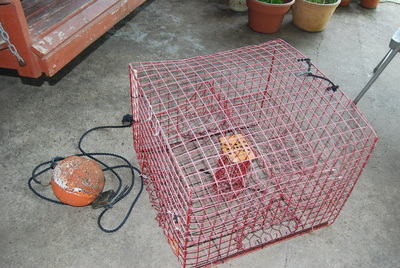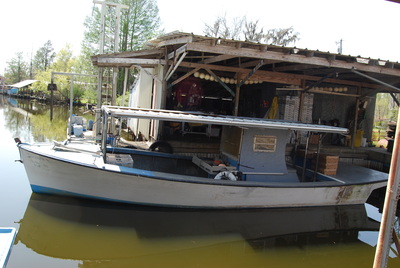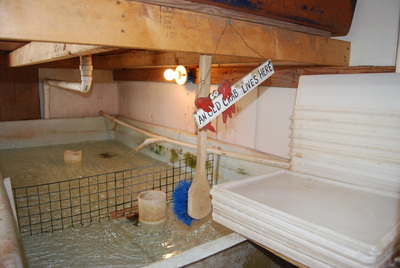During the night, an alarm rings to wake her up every two hours. She’s up to make sure her babies aren’t molting. Molting? Yep. Her babies are crabs. She is not a new mom caring for her infant, or an oilfield waking up to check offshore pumps. Donna Rome sells soft-shell crabs for income and has to periodically check the crabs throughout the night during molting season for several reasons:
• The crabs will eat each other depending on their molting stage.
• Most of the crabs shed their shells at night.
• It takes only two hours for the shell to harden.
Soft-shell crabs grow to almost twice their size after they shed, Rome explains, and it is something that you would have to see to believe. After the crab sheds its shell, she discards them in the trash because she says, “that’s all it is. Just a shell.”
The crabs she is getting up to check on are called busters because these crabs “bust out of their shells,” which is often termed shedding or molting.
“It’s something to see. When you look at it and see that crab backing out of its shell, the crab actually grows,” Rome says. “That’s why it’s busting out because the crab actually outgrows the shell.”
A crab can molt 20 to 25 times in its life.
“When a crab is that small,” Emile Breaux, Rome’s neighbor and fellow crabber, says as he puts his fingers an inch apart indicating the size of the crab, “the crab is steadily shedding maybe an inch at a time. The keep doing that until they get six or seven inches. They are steadily shedding from when they are a baby.”
Rome catches all of the crabs from a freshwater lake near her house in Vacherie with her husband Donnie Rome. On their boat they have:
• Several crab traps in the back of the boat.
• Bait in the back of the boat for the crab traps.
• A rake attached to the side of the boat to pull the crab traps up.
• A pan to sort the different crabs.
• An ice chest to put the blue crabs in (sometimes referred to as green crabs).
• Several different containers to put the buster crabs in.
The Romes put their crab traps out during the spring because the buster crabs start to come out when the water gets warmer. Some winters last longer than others and when that happens, the season starts a little bit later.
“There are certain times, mostly when it’s hot, when you’re going to catch more busters because they shed all the time in the lake,” Rome explains. “Usually when the water is warm, that’s when you have more that will shed and become soft-shells.”
The crabs start molting in March and molt through December.
The trap Rome uses to catch the crabs is a metal, red, square cage with several openings for the crab to get in. In the middle of the cage is a round cylinder called a “bait box” to put the bait in.
“The trap is called a four-funnel crab trap because there are four funnels for the crabs to get in. Once the crabs get in there, they can’t get back out because they swim up," Rome says as she points to an opening in the trap.
And these two rings here, you see these two rings?" Her husband asks as he points to several small round openings on the cage. "That's to let the little babies out. The have to be five inches point to point to be a legal crab. Except for a buster. A buster can be any size."
Another distinct feature that can be seen on the trap is a tag. "All your crab cages have to have a tag on them with your license number and your name on it," Rome says.
Hanging from the side of the cage is a round, red cork attached to a rope. "It stays up on the water and is going to hold that cage there,"says Rome.
The couple leave the traps out on the lake for about three days, and when they come back to check them, they use a rake that is attached to the side of the boat. The rake catches the cork and brings the cages up where Rome's husband is in the back of the boat.
"And when you are ready to take the crabs out, you open it here," the husband says as he pulls on a v-like bungee cord and the cage opens.
"You just open the cage up and dump them into the pan to sort them," Rome adds. "Sometimes, we may have a crab that has a red line or a pink line. I'll pull the different crabs out and put them into separate boxes. You have to separate the busters from the regular crabs."
Rome likes to separate her crabs before she gets home because if she doesn't, the crabs will sometimes eat each other. She saves the "regular green crabs" and peels them to sell the meat. For the buster crabs, she separates them into two different piles:
1. A pink-line buster
2. A red-line buster
"When looking for a buster crab, you're going to look for a certain sign for the crab that's going to indicate it's getting ready to shed," says Rome. "On the back fin of the crab, there is either a pink line or a red line on it, and that's how you know its a buster."
She explains that a pink-line buster will have a thin pink line along the inner border of the back fin and this crab has about one week until it molts. A red-line buster has a thin red line along the inner border of the back fin, and this crab will molt in around three days.
"The busters are little babies; you have to take care of them," she says. "If you don't catch it within two hours it will turn back hard. Then it'll be just like a regular crab, and you'll have to wait for it to start all over again."
When she gets up during the night, she carefully checks each tank in her shed. The tank is about the standard size of a bathtub and sectioned off into three parts. Each section ranges from extra small to medium to large.
"I have one space for pink lines," she says as she points to the largest portion of the tank. "The middle space is for the red lines, and then I have another space that we call the jail," she explains as she points to the smallest slot. "This is where you put the crabs that are cracked in the back and getting ready to back out of their shell."
"Once they back out of their shell, you pick them up, put them in Saran Wrap, put them in the freezer or take them, clean them, and put them in your pot."
Rome explains that for a pound of her peeled blue crab meat whether it’s white, dark, or mixed she sells it for $12 per pound. Depending on the year, that price could go up. For soft-shell crabs she sells them by the dozen:
• Large soft-shell crabs $30
• Medium soft-shell crabs $25
• Small soft-shell crabs $20
Rome doesn’t sell the crabs commercially to seafood markets but sells the crabs to her loyal customers which is made up of family and friends.
On a good year Rome and her husband can make over $6,000. “If it’s a bad year,” Rome explained, “we just don’t fish. Last year was a bad year.”
"If I ever got any problems, I ask my next door neighbor, Emile Breaux, and he helps me with it," says Rome's husband Donnie. "He built the tanks for me and all that. He knows a lot more about soft-shell crabs because he does that for a living."
What is so unique about the tanks is that they are like an aquarium. Underneath the tank is another tank that's filled up with shells and rocks that form bacteria. Water is pumped through this tank and into the one above it that contains the crabs.
"I designed it to rotate the water so the bacteria can grow so the crabs can live," says Breaux. "The water circulates through a sump tank and back into the pipes to keep oxygen in the tanks for the crabs to live."
"What I do for my tank is I start the system in the middle of March every year," he explains as he points to his slightly larger tank with a few crabs in it. "I put two or three crabs in there just to get the bacteria started in the shells. The busters don't really start coming out until the end of the month and beginning of April."
The crabs that Breaux catches are in slightly brackish water compared to the ones the Romes catch in the lake. Though the lake that the Romes fish in is fresh water, Breaux explains that the crabs only lay their eggs in the sand near the gulf in brackish water.
"A lot of people don't know that crabs don't reproduce near lakes. The crabs come to us," Breaux says. "The don't lay nowhere near the fresh water. They lay in saltwater and migrate this way."
“What happens around late December and early January all the female crabs are full of eggs,” Breaux explains. “Around February the females will go onto the beach and lay their eggs. The female dies and all the babies starting in March will start migrating to us.”
When preparing a soft-shell crab to shed, it is best not to feed it because at this stage it is no longer eating, explains Breaux. "The reason he's not eating is because he's full and fat. So he's got to come out that shell, and then when it's going to turn back hard is when it's going to eat."
When Breaux started harvesting soft-shell crabs over 25 years ago, he acquired his systems from Louisiana State University. His friend gave him some papers to read and he learned about the process from older people he knew who did soft-shell crabs in the area.
"It's a good living, but it's a hard living too. It ain't easy, you know," Breaux explains. "When you get those years that you make money and then you get those years that, you know, that, that's just tough. You use all that money that takes to survive when you get a tough year, you know. But then, Mother Nature lets it come back. You just got to stick with it."
As a commercial fisherman, on a good year Breaux can make around $30,000. He sells the crabs that he catches to a crab dock in Des Allemands or to his father, who owns B & C Seafood Market and Cajun Restaurant in Vacherie.
“The majority of the crabs I sell is at a crab dock. They can take a volume of it and not just a couple of pans of crabs,” Breaux says. “Sometimes I’ll catch up to 1,500 pounds of crabs, but most of the time it’s under 1,000.”
The money he makes on selling the crabs depends on what the market is buying them for. It’s a supply and demand market. Breaux explained they pay the most money at the beginning of the crabbing season around the middle of March because the crabs aren’t always plentiful at this time. “When we have plenty crabs, the price goes cheap. But that’s how it works every year.”
For Breaux’s soft-shell crabs he sells them by the dozen: $40 for large, $35 for medium and $30 for small.
Compared to Breaux, the Romes' crabs are much smaller, and they don't crab for a steady income like he does. "Right here it's all junk crabs that we catch in the lake," says Donnie Rome. "It's enough crabs to peel and get the meat out of to sell like we do, but you don't get your number one or number two crabs."
Number one and two crabs are larger crabs that are sold commercially to serve in restaurants and seafood markets.
We mostly catch what they call factory crabs. Picking crabs,"says Rome. "That's why you gotta go somewhere else to catch the good crabs."
For now the crabs they catch are good enough for them.
Though Donna Rome is not a mother of a newborn baby, she will get up every two hours to check on her molting crabs during the springtime. Like caring for a newborn baby, time will pass and the seasons will change. Thankfully for Donna Rome, it only happens for a short time period every year.




 RSS Feed
RSS Feed
